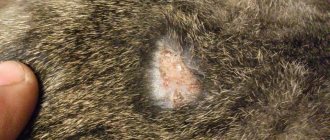/ Hamsters / Causes of tumors in hamsters
0
3203
Article rating
Pet hamsters can suffer from various diseases. Sometimes the cause of a particular disease cannot be determined. A tumor or neoplasm is one of the most common pathologies that appears in mature adults. According to statistics, every tenth animal of the Hamyakov family suffers from this problem. What causes tumors in hamsters and how to treat them? In this article we will talk about this in detail.
Causes of tumors in hamsters
A tumor is not always oncology
If you notice a strange growth on your hamster's body, don't panic right away. The causes of tumors vary. But the most important thing is that they are not only malignant, but also benign.
Benign tumors in rodents
Benign tumors are easily removed surgically, since they do not adhere to tissues and do not invade other parts of the body. Typically, such tumors do not lead to death, but due to the fact that they grow very quickly and reach impressive sizes, it may be difficult for the animal to move and the hamster will no longer eat enough to maintain its vital functions. But if you consult a doctor in time, your pet will be safe and sound.
Malignant tumors in rodents
Malignant tumors, also known as cancer, lead to death. They affect other organs, penetrate healthy cells and change DNA. Since the tumor is adjacent to healthy areas, it is impossible to operate on animals and soon the pet dies due to failure of the affected organs.
Treatment is prescribed depending on the location of the tumor
Causes of seals
It is very sad when a small creature develops tumors. Moreover, they can be of different sizes - from a barely noticeable bump to a huge tumor. Veterinarians say that female Djungarians suffer from this disease much more often than males and representatives of other breeds. This is associated with their reproductive characteristics.
In general, Djungarian hamsters are quite susceptible to diseases; they suffer from viral diseases more often than other breeds. Scientists have long put forward a viral theory of cancer; perhaps it extends to small rodents. The question of what provokes the occurrence of tumors in hamsters has not yet been fully clarified.
However, the reasons for compaction on the body of small animals may be:
- bruises and fractures;
- local reproduction of viruses;
- poor nutrition;
- inflammatory process;
- congenital pathologies.
Since the reasons for the appearance of lumps vary, the types of tumors will also be different.
Localization of neoplasms
Lump on cheek
A growth on a hamster's cheek or a swollen face can cause inflammation of the mouth or cheek pouches. This happens due to improper nutrition or poor quality food.
Such pets should not be given hard food that contains small bones or may be prickly. Such food can damage the oral mucosa and form wounds in which bacteria develop and cause inflammation. This problem cannot be eliminated with medication. For treatment, you need to contact a veterinarian to clean and disinfect the wounds.
Neoplasm on the neck
Swelling in a hamster's neck most often indicates inflammation of the lymph nodes. This is caused by a viral or bacterial infection. During illness, pets can be very aggressive, as the tumor is very painful. Hamsters also lose their appetite. If a tumor is detected on the animal’s neck, you should immediately consult a doctor, as the body will begin to fight the disease itself, and this will lead to even greater inflammation and death.
Neoplasms under the tail
Very often, during puberty, male hamsters have enlarged testicles. There is no need to sound the alarm right away. Most often this is an accumulation of seminal fluid, you just need to find a female for your pet.
But if the testes remain swollen for a long time, turn red and become hot, then most likely it is cancer.
In this case, the only solution is castration. In some cases, swollen testicles can be treated with antibiotics prescribed by your veterinarian. Has your hamster lost his appetite?
Lump on the side of the body
The causes of a tumor in the side of a hamster's body are varied: from injury to malnutrition. It is difficult to determine the cause on your own; you need to seek help from a specialist. Such tumors can be treated only after consultation with a veterinarian.
The girl has breast tumors
Lumps on the abdomen
A tumor on the abdomen in females is most often found in the mammary glands. It can be either malignant or benign. Since such tumors are located on the outer part of the abdomen, they can be removed surgically.
If you find a tumor on the abdomen of a male hamster, then most likely it is inflammation of the marker glands.
Attention! This is not oncology and such a disease in no case requires surgical intervention.
Other neoplasms
Often, due to improper handling of hamsters or improper bedding, injuries and cracks can form on the pet's body, which lead to tumors. Bedding with small particles should be avoided and play with animals very carefully.
There are also two very common diseases among hamsters that can lead to tumors. Osteosarcoma is a dangerous viral disease that cannot be treated and is fatal. It is manifested by infection of tissues by a virus and proliferation of bone tissue. Typically, osteosarcoma is localized on the animal's limbs, but over time the tumor can spread to the body.
Another disease that is also caused by a virus is papilloma. It can appear due to an insect bite, a break in the skin, or after contact with another sick hamster. You can bring an already infected pet from the pet store, since papillomas do not appear immediately, but after 1-2 months. Such neoplasms first appear as small tubercles on the body, and over time can reach 2-3 cm in size.
If you find such a tumor on your pet’s body, you should contact your veterinarian to get the correct treatment. Most often, it involves applying a special paste to the papilloma, which is then covered with a bandage.
An abscess is an inflammation with a purulent cavity
Treatment
Some bumps are painless for your pet, but that doesn't mean your pet doesn't need to be treated. What to do if you find strange bulges? Of course, consult your doctor.
An ordinary veterinarian can easily recognize eye diseases and prescribe antibiotic treatment. If a hamster has a lump on its neck, it will also not be difficult for him to diagnose inflammation of the lymph nodes. The veterinarian is also able to open the abscess, remove accumulated pus from the wound and treat it.
But with more serious illnesses, you will have to contact a specialist with a narrow profile - a ratologist. This doctor deals exclusively with rodents, examines and makes a diagnosis. One problem: not every city offers appointments with this specialist.
After diagnosis, treatment or surgery is prescribed. If a hamster's cheek is swollen, the doctor will examine the pet's oral cavity, remove foreign objects (possibly embedded in the cheek), and treat the inflamed areas with an antibacterial drug. Usually after the procedure, the swelling subsides within 1-2 days.
If your hamster's butt is swollen but it is not due to puberty, surgery may be necessary. The same situation is with diseases of the mammary glands. Not long ago, operations to remove uterine tumors in rodents became possible. But malignant neoplasms have never been treated. The most humane thing to do is to euthanize an animal with cancer so that it does not suffer.
Abscess in a hamster
An abscess is an inflammation after which a purulent cavity appears. It is characterized by painful sensations, decreased appetite in the animal, discharge and redness.
Causes
- a bite received from another hamster;
- impact or scratches from improperly selected bedding;
- a hamster can get injured on low-quality toys or on a cage, which in turn will lead to the development of an abscess.
How to treat?
If you managed to notice an abscess in the early stages, when it has not yet matured and looks like a small swelling, then treatment may simply consist of taking antibiotics, which are prescribed exclusively by a veterinarian. If a purulent cavity has already formed, then treatment will not be possible without surgical procedures. In some cases, you can get by by rinsing the cavity with a special solution, but in some cases, installing drainage is required.
Make sure that the abscess is not advanced. Since hamsters are small in size, even a small accumulation of pus leads to intoxication of the body.
Important! If you do not attach importance to the abscess and do not treat it properly, the disease becomes chronic. A wound forms at the site of the abscess, which takes a very long time to heal.
How to prevent it?
- If you notice a small scratch on your pet's body, give him the opportunity to take care of himself. Hamsters themselves lick and clean small wounds.
- If you treat wounds yourself, you should limit your hamster's movements. Before the procedure, wrap your pet in a scarf or small towel, as during illness they become restless and may bite or injure themselves further.
- Treat wounds and scratches with an antiseptic, and then apply an ointment that your veterinarian will recommend. Flushing will help prevent the development of an abscess.
There are various reasons
When is surgery necessary?
If your pet does have a tumor, and the doctor confirms the disappointing diagnosis, the only option left is surgical removal. There is no point in delaying the operation; diseases in dwarf hamsters and other breeds of hamsters progress very quickly. As long as the hamster's tumor is small, it will be easier to undergo surgery. Removing the affected organ may, if not completely cure the animal, then at least prolong and make the rest of its life easier.
An experienced doctor will perform the operation under inhalation anesthesia. The use of such anesthesia has recently increased the percentage of successful operations to remove tumors in decorative rodents.
Causes of tumors, lumps and abscesses in hamsters
The causes of neoplasms or abscesses vary. The most common are:
- injuries and bruises;
- scratches and open wounds;
- improper diet;
- incorrectly selected litter;
- inflammatory processes in the body;
- congenital pathologies;
- stress.
What to do if you find a tumor in your hamster?
If you notice a tumor or lump on your pet's body, you should immediately contact a ratologist to determine whether the tumor is benign or malignant.
Reference! You should not treat the hamster yourself, as this can be fatal.
In any case, you should consult a doctor
How to treat an abscess
An abscess is often mistaken for a tumor - a common purulent neoplasm that arises as a result of infection.
It appears as follows:
- swelling of the affected area;
- deterioration of general condition;
- loss of appetite;
- ugly coat;
- excessive salivation;
- protrusion and purulence of the eyes.
An abscess occurs at the sites of bites, scratches, and wounds. They quickly become infected and the inflammatory process begins. If you notice one of the listed symptoms and find that there is wet fur and pus at the site of the injury, then you should immediately go to the veterinary clinic. The doctor will assess the condition of the problem. If it is at an early stage, then you can get by with regular rinsing and antibiotics. If the wound is already opening, then you will have to open it, disinfect it and apply an antiseptic (Fitoelita, Levomekol). As a last resort - surgical intervention.
Find out what to do if your hamster breaks its leg.
Treatment and prevention of tumors in hamsters
If the tumor turns out to be benign, then you can resort to preventive procedures. But if the tumor is malignant, surgical intervention is required. Most often this is amputation of limbs. If an inflammatory process has formed on the pet’s body, then treatment consists of taking antibiotics.
In cases where a pet develops oncology in soft tissues, the best way out of the situation is euthanasia. Since such a disease will spread to healthy tissues and, sooner or later, the hamster will die.
To avoid tumors and neoplasms on your pet’s body, you should follow some preventive actions:
- Change the bedding and wash the cage regularly.
- Choose high-quality food for your hamster, without nitrates and preservatives.
- Monitor your pet's emotional state.
- Make sure that toys and accessories have no sharp corners.
- Do not take your pet outside to avoid catching a cold.
- Equip the cage with a wheel or a maze.
Prevention
Preventive measures cannot fully guarantee protection against cancer and other diseases, but the risk of disease is reduced many times over. To protect your cute animal, follow these rules:
- Clean the cage and wash it often, this will reduce the population of pathogens.
- Do not allow rodents to mate frequently if you have a married couple living with you. Remember that childbirth significantly undermines the body's defenses.
- Do not feed animals fatty foods.
- Take care of your animal's immunity. Fresh herbs and vegetables are great for this purpose.
Following these recommendations will have a good effect on the mood and health of the furry, prevent the occurrence of infectious diseases, and reduce the risk of tumors.
At the first symptoms of the disease, you should not self-medicate, but run to the doctor. Timely diagnosis and therapy will help cope with a number of diseases, but if your furry friend is diagnosed with cancer, you will have to come to terms with it.
Lumps on the abdomen
Sometimes neoplasms in rodents appear on the abdomen. In most cases, a tumor on the abdomen appears in mature females in the area of the mammary glands and can be either benign or malignant. Since this growth is not internal, it can be removed.
When examining males, it is necessary to remember that their marker glands are located on the abdomen, which are often confused with a sore. In Djungarian hamsters, the gland is yellowish in color and covered with a crust. Syrians have two of them, they are placed in front of the hind legs symmetrically on both sides and resemble an oval black bald spot.
This is not swelling in the hamster’s abdomen, but an anatomical formation and does not need to be treated. But in order to avoid inflammation or neoplasm in the area of the scent gland, an examination is necessary.
Diseases of Djungarian hamsters and symptoms
Despite the fact that these rodents are miniature, they face a number of dangers. Some of them can be dealt with on your own, but for more serious diseases, be prepared to contact the YA-VET veterinary care center. In principle, distinguishing a healthy hamster from a sick one is not so difficult. A healthy hamster has dry, smooth-to-the-touch fur with a slight shiny sheen, even, measured breathing, and a dry rim of the eyes and nose. The behavior of a healthy dwarf is playful and active, and the appetite should also be saturated.
In a sick hamster, symptoms usually appear immediately, since their metabolism is very fast, the presence of a wet tail, accompanied by diarrhea, blood discharge is also possible, which can subsequently bring such an unpleasant symptom to the animal as dehydration, which causes the body temperature to rise, and behavior changes to the point of complete lethargy. Next comes death. All diseases with complications can worsen and move into other phases of the disease, building a whole chain of unpleasant painful events.
What diseases lie in wait for Djungarian hamsters?
Diseases of Djungarian hamsters are varied, let's look at some of them.
1 Mechanical injuries or bruises, fractures, scratches and even fainting occur as a result of a fall from a height or during the manifestation of your boundless love for a rodent. Such falls are fraught with bruises to internal organs. Symptoms include a painful appearance of your animal, namely problematic movement and twisted limbs. 2 Colds - here, in general, the disease and accompanying symptoms are characteristic, as with any living creature. The activity of the animal is reduced, pain is accompanied by sneezing, snoring, and lack of appetite. It is easy to notice the presence of the disease by the low activity of the hamster. 3 Eye diseases - conjunctivitis, purulent discharge, sticking of eyelids. A visual examination of the animal will give a complete picture of the presence of the disease. But there is also an incurable disease called cataracts in the eyes of a hamster. In this case, the animal requires much more care and attention. 4An equally common problem is the problem with the teeth of a rodent; excessive growth in the length of the teeth interferes with the life of hamsters; also, due to mechanical injuries, any parts of the teeth can be damaged. To identify this disease, it is enough to conduct a visual examination. 5Skin and coat diseases - dermatophytosis and eczema are accompanied by skin exfoliation and hair loss. This disease is very easy to identify by performing a visual examination. 6 Intestinal diseases - an upset stomach of the baby is accompanied by loose stools and an unpleasant odor. 7And finally, the most common problem is the formation of lumps; many owners have the opinion that a newly formed lump is a cancerous disease. Do not worry, it is important to contact a qualified specialist who will accurately determine your pet’s disease. Perhaps it was an unfortunate injury from a fall. 8Constipation - improper feeding, lack of moisture and dry food contribute to poor digestion. The disease can be identified by highlighting the symptoms - small droppings in the cage, other forms of bending during bowel movements, the animal makes a squeak. Also loss of appetite. 9Allergies - such a small creature is also susceptible to allergic reactions. The symptoms are similar to those in humans - sneezing, itchy nose, liquid discharge from the mucous membranes of the eyes and nose. 10 Shedding - in general, this cannot be called a disease if we assume that shedding is inherent in nature, but there are also pathological complications when the fur comes off due to a lack of vitamins in the animal’s body. 11 Obesity is not so much a disease as it is an oversight of the owners. By pampering his animal with goodies, the owner of the hamster, without knowing it, dooms him to gain excess weight, which in turn causes shortness of breath and great stress on the heart. Fat hamsters don't live long.
Diseases of Djungarian hamsters transmitted to humans
At home, the diseases that will now be described are quite rare.
, but it’s still better to be prepared for any ailment of the domestic dwarf. And so let's look at:
- Rabies - the hamster begins to behave aggressively, squeaking and biting for no reason.
- Tuberculosis - makes hoarse moans, breathes heavily. Weight loss and decreased activity.
- Parasites Ticks - itching, wounds, hair loss, rodent squeaking, abscess.
- Listeriosis - fainting, loss of coordination.
- Tizzer's disease - severe diarrhea, apathy, the hamster is shaking.
Types of neoplasms in rodents
Bumps in rodents can appear on the limbs, skin or subcutaneous tissue (external), and internal tumors may also appear (on the uterus, in the intestines). Depending on the etiology, compactions are divided into:
- Benign neoplasms - occur after injuries, viral diseases or are caused by genetic failures. Outwardly, they resemble subcutaneous balls of small sizes and varying densities, which, with light pressure, move to the side. They should be removed to avoid the development of cancer.
- Malignant neoplasms develop either immediately or degenerate from benign ones. The oncological tumor is not localized, metastases spread to different organs of the rodent. Their appearance is provoked by genetic failures, poor nutrition (carcinogenic substances), and viruses.
- Inflammatory processes in tissues are also characterized by swelling, which occurs when pus or lymph accumulates in some areas.
An abscess in a hamster, tissue inflammation or a benign tumor can be treated, but oncology in an animal is incurable.











